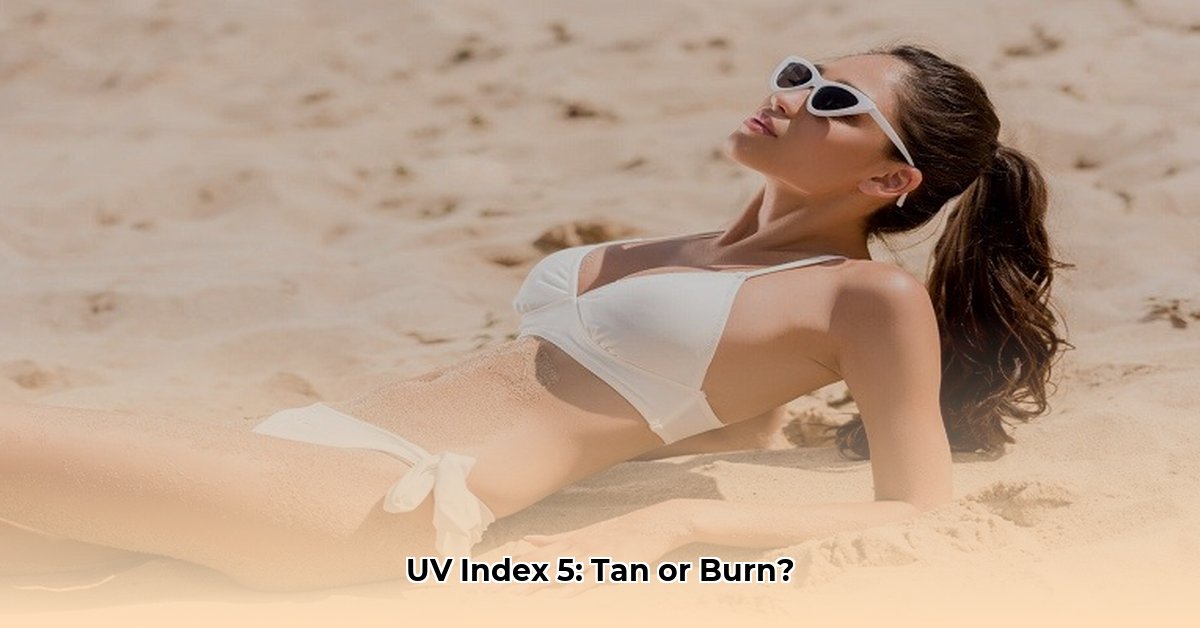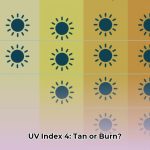Yes, you can tan in a UV index of 5, but it’s important to do so with caution. While a UV index of 5 is considered moderate, it still poses risks to your skin. This guide provides essential information on how to tan safely in UV 5 while emphasizing the importance of protecting your skin from sun damage.
Understanding UV Index 5
A UV index of 5 signifies moderate UV radiation intensity. This means unprotected skin can probably begin to burn in approximately 30-45 minutes, depending on individual skin type and other factors. At this level, taking precautions to minimize sun exposure and protect your skin is crucial.
UV Index Quick Reference
| UV Index | Exposure Level | Risk of Sunburn | Recommended Protection |
|---|---|---|---|
| 0-2 | Low | Low | Minimal protection is likely sufficient for shorter periods. Consider sunscreen for extended time outdoors. |
| 3-5 | Moderate | Moderate | Sun protection is necessary. Use SPF 30+ sunscreen, seek shade during peak hours, and wear protective clothing. |
| 6-7 | High | High | Limit sun exposure during peak hours. Protective clothing, a wide-brimmed hat, and sunglasses are essential. |
| 8-10 | Very High | Very High | Minimize sun exposure, especially between 10 a.m. and 4 p.m. Prioritize protective clothing and sunscreen. |
| 11+ | Extreme | Extreme | Avoid sun exposure. If outdoors is unavoidable, cover up completely and seek shade whenever possible. |
How to Tan Safely in UV Index 5: A Step-by-Step Guide
While a “safe tan” is a misnomer, these steps can help mitigate risks:
-
Choose the Right Sunscreen: Select a broad-spectrum sunscreen with an SPF of 30 or higher. This will help block both UVA and UVB rays.
-
Apply Sunscreen Correctly: Apply liberally 15-30 minutes before sun exposure. Reapply every two hours, or immediately after swimming or sweating, even if using a water-resistant sunscreen. Ensure complete coverage, like frosting a cake.
-
Time Your Sun Exposure: Limit exposure during peak sun hours (10 a.m. to 4 p.m.). Early morning or late afternoon sun is generally less intense.
-
Understand Your Skin Type: Fair-skinned individuals are more susceptible to sunburn and should take extra precautions.
-
Seek Shade: Utilize natural shade (trees, buildings) or create your own with umbrellas or wide-brimmed hats.
Risks of Tanning
Even at a moderate UV index like 5, tanning poses risks:
-
Premature Aging: Sun exposure can lead to wrinkles, age spots, and a loss of skin elasticity.
-
Skin Cancer: The most significant risk is skin cancer. Any tan is a sign of skin damage and increases your risk.
-
Sunburn: Prolonged exposure, even at a UV index of 5, might result in sunburn. Sunburns increase your risk of both premature aging and skin cancer.
Sunless Tanning Alternatives
Consider sunless tanning products like lotions, sprays, or professional spray tans for a safer way to achieve a tanned look. These products create a temporary tan without UV exposure.
What to Do if You Get Sunburned
If you get sunburned:
- Apply cool compresses.
- Use aloe vera gel to soothe the skin.
- Take over-the-counter pain relievers if needed.
- Stay hydrated.
- Consult a doctor for severe sunburns.
Checking Your Local UV Index
Check your local weather forecast or use a UV index app from the EPA before heading outdoors.
The Vitamin D Factor
While some sun exposure is necessary for vitamin D production, it’s possible to obtain sufficient amounts through diet, supplements, and limited, protected sun exposure without intentionally tanning.
Conclusion
A UV index of 5, while moderate, still requires mindful sun protection practices. Prioritizing skin health over a tan is essential for preventing long-term damage.
Disclaimer: This information is for educational purposes only and is not a substitute for professional medical advice. Consult a dermatologist for any concerns about sun exposure or skin health.
- Wellness Fair Ideas for Work to Boost Employee Wellbeing - December 15, 2025
- Affordable Employee Wellness Fair Ideas for Any Budget - December 14, 2025
- Employee Wellness Programs Strategically Benefit Employee Health And Retention - December 13, 2025
















